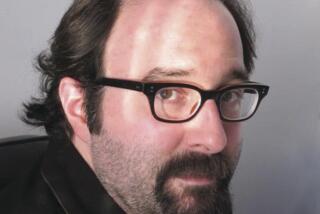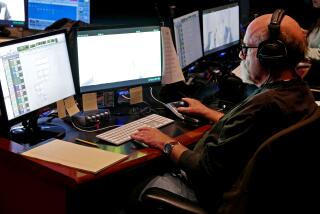New Firm Leads Market for Better Movie Sound : Film: With Steven Spielberg giving it a big break, Digital Theater Systems’ separate CD format has a shot at becoming the standard in theaters.
- Share via
To start a new business in the closed, clubby world of Hollywood, you need money and connections. When Terry Beard developed a new digital sound format for movies, he had both.
Beard is a Caltech-trained engineer who spent 20 years inventing much of the stereo optical recording equipment used in movie production. He got a friend, who was also a friend of director Steven Spielberg, to help arrange a demonstration for Spielberg of a new movie sound system he invented called Digital Theater Systems.
As Spielberg watched and listened to scenes of his “Close Encounters of the Third Kind” in DTS, he was converted.
“I was flabbergasted,” Spielberg said. He recalls switching back and forth from the traditional soundtrack to DTS. “It sounded exactly like 70-millimeter six-track sound.”
But Spielberg worried about one thing: The DTS format stores the movie digital sound track on a separate compact disc. If the disc became separated from the film, or failed, would his movie become a silent film? DTS argued that its system was fail-safe; if the digital sound track didn’t work, the traditional analog sound track would kick in.
As Spielberg prepared the release of “Jurassic Park,” the director told Universal Studios he wanted the sound track of his blockbuster-to-be in DTS. So Universal bought $4 million worth of DTS hardware to equip 1,000 theaters for the digital sound version of “Jurassic Park.”
It was DTS’ big break. The dinosaur epic lent credibility to the format, and in July Spielberg bought a minority stake in Beard’s Westlake Village-based Digital Theater Systems company, as did Universal Studios. Universal and Spielberg’s production company, Amblin Entertainment, soon committed to release all their pictures in DTS. Spielberg’s current film, “Schindler’s List,” is also using the format.
Now Beard, who is president of DTS, is competing with Dolby Laboratories Inc. and Sony to emerge as the dominant digital sound system for movie theaters.
Since 1992, Dolby, based in San Francisco, has been marketing its Dolby Stereo Digital sound for movies. Sony, parent of Columbia Pictures, TriStar and Sony Pictures Classics, is also competing with its Sony Dynamic Digital Sound.
Dolby said there is little difference in the sound quality between its system and DTS. But it believes the presence of its digital sound track on the film print, rather than on a separate disc, is an advantage. “There have been many examples of film technology in the past, such as the early talkies, where film and sound were on separate components. They can become separated,” said Joe Hull, a spokesman for Dolby.
However, DTS claims that its system is safe, and that by using CDs for sound studios will save money when they dub their films for overseas markets, rather than having to have another film print made.
With the backing of Spielberg and Universal, DTS is gaining ground against its competitors. By the first week of January, DTS’ digital sound equipment will be in 2,000 theaters worldwide, according to the company. That’s compared to Dolby Stereo Digital’s presence in 500 theaters worldwide. Sony won’t officially be in the marketplace until spring 1994, but it has been testing its prototypes for months.
Studio and movie theater executives believe only one digital movie sound format will prevail and they predict a shake-out within two years. Exhibitors don’t want to buy multiple pieces of equipment, so many are holding back to see which format becomes the standard.
“We’re all searching for efficiency. This smorgasbord isn’t acceptable,” said Greg Rutkowski, vice president of western operation for AMC Theaters, the Kansas City, Mo.-based theater chain.
“Our philosophy is that digital sound and DTS will be the standard release format,” said Bill Neighbors, DTS’ vice president and general manager.
Like the compact discs people listen to at home, digital movie sound tracks offer crystal clear tones delivered with the help of computer technology. Since CDs are impervious to wear and tear, the sound track doesn’t have the hisses and pops associated with traditional movie sound.
With DTS’ six-channel system, the film carries a time code to keep the sound track in sync with the movie. So far, DTS has had only a few instances in which the digital sound has cut out briefly, according to Neighbors.
Neighbors estimates that DTS will post sales of $6 million for the 10 months ending December 31. Next year, Neighbors expects sales to climb to $10 million.
Even without its competitors, DTS must overcome bad memories left by the digital movie sound pioneer. In 1990, now-defunct Optical Radiation Corp., put its digital sound format on Walt Disney Co.’s “Dick Tracy” and Paramount Pictures’ “Days of Thunder,” plus a few other films. There were a few well-publicized incidents in which that digital sound track failed. And because there was no back-up, the movies went silent.
Once burned, Hollywood studios have been reluctant to sign on with another digital sound format.
But movie director Steve Kloves, who did “The Fabulous Baker Boys,” saw a DTS presentation and liked it. So he pushed to use it in his Paramount film, “Flesh and Bone.” So far, Paramount is approaching this on a picture-by-picture basis. “I like the digital sound system on “Flesh and Bone,” said studio senior vice president Paul Haggar. “But that doesn’t mean we won’t use Dolby in the future.”
New Line Cinema has signed on to release six pictures using the DTS process. “DTS seems to be trouble-free and it’s relatively inexpensive for exhibitors,” said Mitch Goldman, New Line president of marketing and distribution.
More to Read
The biggest entertainment stories
Get our big stories about Hollywood, film, television, music, arts, culture and more right in your inbox as soon as they publish.
You may occasionally receive promotional content from the Los Angeles Times.










